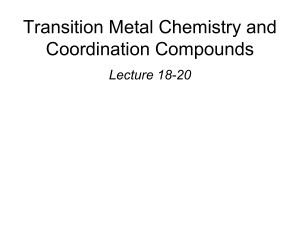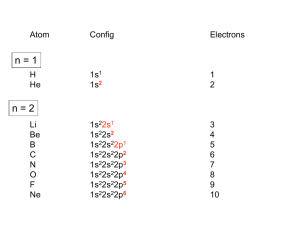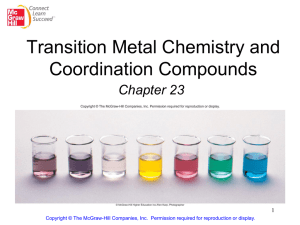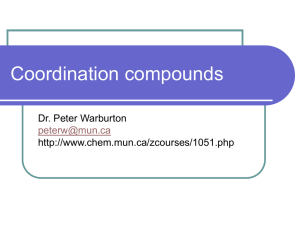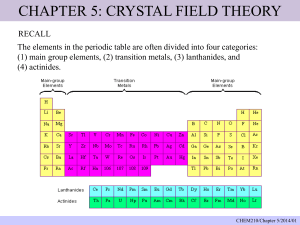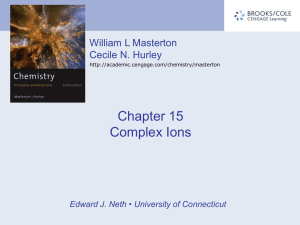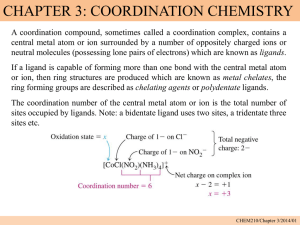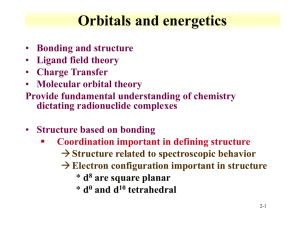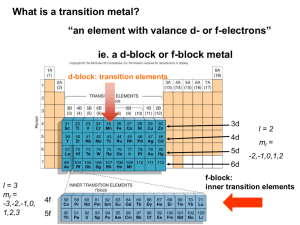Transition Metals and Coordination Compounds
advertisement
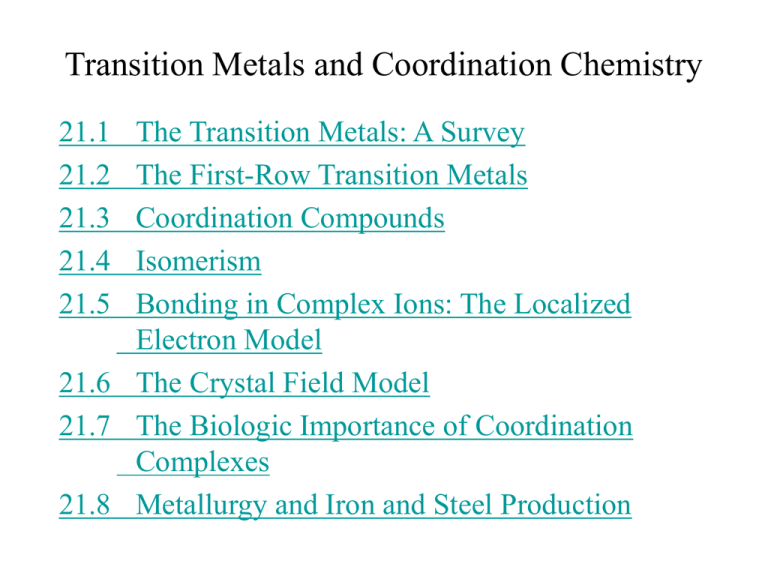
Transition Metals and Coordination Chemistry 21.1 21.2 21.3 21.4 21.5 The Transition Metals: A Survey The First-Row Transition Metals Coordination Compounds Isomerism Bonding in Complex Ions: The Localized Electron Model 21.6 The Crystal Field Model 21.7 The Biologic Importance of Coordination Complexes 21.8 Metallurgy and Iron and Steel Production Transition Metals • Show great similarities within a given period as well as within a given vertical group. The Position of the Transition Elements on the Periodic Table Forming Ionic Compounds • Transition metals generally exhibit more than one oxidation state. • Cations are often complex ions – species where the transition metal ion is surrounded by a certain number of ligands (Lewis bases). The Complex Ion Co(NH3)63+ Ionic Compounds with Transition Metals • Most compounds are colored because the transition metal ion in the complex ion can absorb visible light of specific wavelengths. • Many compounds are paramagnetic. Electron Configurations • Example V: [Ar]4s23d3 Fe: [Ar]4s23d6 • Exceptions: Cr and Cu Cr: [Ar]4s13d5 Cu: [Ar]4s13d10 Electron Configurations • First-row transition metal ions do not have 4s electrons. Energy of the 3d orbitals is less than that of the 4s orbital. Ti: [Ar]4s23d2 Ti3+: [Ar]3d1 Concept Check What is the expected electron configuration of Sc+? Explain. [Ar]3d2 Plots of the First (Red Dots) and Third (Blue Dots) Ionization Energies for the First-Row Transition Metals Atomic Radii of the 3d, 4d, and 5d Transition Series 3d Transition Metals • • • • • • • • • • Scandium – chemistry strongly resembles lanthanides Titanium – excellent structural material (light weight) Vanadium – mostly in alloys with other metals Chromium – important industrial material Manganese – production of hard steel Iron – most abundant heavy metal Cobalt – alloys with other metals Nickel – plating more active metals; alloys Copper – plumbing and electrical applications Zinc – galvanizing steel Oxidation States and Species for Vanadium in Aqueous Solution Typical Chromium Compounds Some Compounds of Manganese in Its Most Common Oxidation States Typical Compounds of Iron Typical Compounds of Cobalt Typical Compounds of Nickel Typical Compounds of Copper Alloys Containing Copper A Coordination Compound • Typically consists of a complex ion and counterions (anions or cations as needed to produce a neutral compound): [Co(NH3)5Cl]Cl2 [Fe(en)2(NO2)2]2SO4 K3Fe(CN)6 Coordination Number • Number of bonds formed between the metal ion and the ligands in the complex ion. 6 and 4 (most common) 2 and 8 (least common) Ligands • Neutral molecule or ion having a lone electron pair that can be used to form a bond to a metal ion. Monodentate ligand – one bond to a metal ion Bidentate ligand (chelate) – two bonds to a metal ion Polydentate ligand – more than two bonds to a metal ion Coordinate Covalent Bond • Bond resulting from the interaction between a Lewis base (the ligand) and a Lewis acid (the metal ion). The Bidentate Ligand Ethylenediamine and the Monodentate Ligand Ammonia The Coordination of EDTA with a 2+ Metal Ion ethylenediaminetetraacetate Rules for Naming Coordination Compounds [Co(NH3)5Cl]Cl2 1. Cation is named before the anion. “chloride” goes last (the counterion) 2. Ligands are named before the metal ion. ammonia (ammine) and chlorine (chloro) named before cobalt Rules for Naming Coordination Compounds [Co(NH3)5Cl]Cl2 3. For negatively charged ligands, an “o” is added to the root name of an anion (such as fluoro, bromo, chloro, etc.). 4. The prefixes mono-, di-, tri-, etc., are used to denote the number of simple ligands. penta ammine Rules for Naming Coordination Compounds [Co(NH3)5Cl]Cl2 5. The oxidation state of the central metal ion is designated by a Roman numeral: cobalt (III) 6. When more than one type of ligand is present, they are named alphabetically: pentaamminechloro Rules for Naming Coordination Compounds [Co(NH3)5Cl]Cl2 7. If the complex ion has a negative charge, the suffix “ate” is added to the name of the metal. The correct name is: pentaamminechlorocobalt(III) chloride Exercise Name the following coordination compounds. (a) [Co(H2O)6]Br3 (b) Na2[PtCl4] (a) Hexaaquacobalt(III) bromide (b) Sodium tetrachloroplatinate(II) Some Classes of Isomers Structural Isomerism • Coordination Isomerism: Composition of the complex ion varies. [Cr(NH3)5SO4]Br and [Cr(NH3)5Br]SO4 • Linkage Isomerism: Composition of the complex ion is the same, but the point of attachment of at least one of the ligands differs. Linkage Isomerism of NO2– Stereoisomerism • Geometrical Isomerism (cis-trans): Atoms or groups of atoms can assume different positions around a rigid ring or bond. Cis – same side (next to each other) Trans – opposite sides (across from each other) Geometrical (cis-trans) Isomerism for a Square Planar Compound (a) cis isomer (b) trans isomer Geometrical (cis-trans) Isomerism for an Octahedral Complex Ion Stereoisomerism • Optical Isomerism: Isomers have opposite effects on planepolarized light. Unpolarized Light Consists of Waves Vibrating in Many Different Planes The Rotation of the Plane of Polarized Light by an Optically Active Substance Optical Activity • Exhibited by molecules that have nonsuperimposable mirror images (chiral molecules). • Enantiomers – isomers of nonsuperimposable mirror images. A Human Hand Exhibits a Nonsuperimposable Mirror Image Concept Check Does [Co(en)2Cl2]Cl exhibit geometrical isomerism? Yes Does it exhibit optical isomerism? Trans form – No Cis form – Yes Explain. Bonding in Complex Ions 1. The VSEPR model for predicting structure generally does not work for complex ions. However, assume a complex ion with a coordination number of 6 will have an octahedral arrangement of ligands. And, assume complexes with two ligands will be linear. But, complexes with a coordination number of 4 can be either tetrahedral or square planar. Bonding in Complex Ions 2. The interaction between a metal ion and a ligand can be viewed as a Lewis acid–base reaction with the ligand donating a lone pair of electrons to an empty orbital of the metal ion to form a coordinate covalent bond. The Interaction Between a Metal Ion and a Ligand Can Be Viewed as a Lewis Acid-Base Reaction Hybrid Orbitals on Co3+ Can Accept an Electron Pair from Each NH3 Ligand The Hybrid Orbitals Required for Tetrahedral, Square Planar, and Linear Complex Ions Crystal Field Model • Focuses on the effect of ligands on the energies of the d orbitals of metals. Assumptions 1. Ligands are negative point charges. 2. Metal–ligand bonding is entirely ionic: • strong-field (low–spin): large splitting of d orbitals • weak-field (high–spin): small splitting of d orbitals Octahedral Complexes • point their lobes directly at the point-charge ligands. • d xz , dyz ,and d xy point their lobes between the point charges. d z and d x 2 2 y2 An Octahedral Arrangement of Point-Charge Ligands and the Orientation of the 3d Orbitals Which Type of Orbital is Lower in Energy? • Because the negative point-charge ligands repel negatively charged electrons, the electrons will first fill the d orbitals farthest from the ligands to minimize repulsions. • The d xz , dyz ,and d xy orbitals are at a lower energy in the octahedral complex than are the d z and d x y orbitals. 2 2 2 The Energies of the 3d Orbitals for a Metal Ion in an Octahedral Complex Possible Electron Arrangements in the Split 3d Orbitals in an Octahedral Complex of Co3+ Magnetic Properties • Strong–field (low–spin): Yields the minimum number of unpaired electrons. • Weak–field (high–spin): Gives the maximum number of unpaired electrons. • Hund’s rule still applies. Spectrochemical Series • Strong–field ligands to weak–field ligands. (large split) (small split) CN– > NO2– > en > NH3 > H2O > OH– > F– > Cl– > Br– > I– • Magnitude of split for a given ligand increases as the charge on the metal ion increases. Complex Ion Colors • When a substance absorbs certain wavelengths of light in the visible region, the color of the substance is determined by the wavelengths of visible light that remain. Substance exhibits the color complementary to those absorbed. Complex Ion Colors • The ligands coordinated to a given metal ion determine the size of the d–orbital splitting, thus the color changes as the ligands are changed. • A change in splitting means a change in the wavelength of light needed to transfer electrons between the t2g and eg orbitals. Absorbtion of Visible Light by the Complex Ion Ti(H2O)63+ Concept Check Which of the following are expected to form colorless octahedral compounds? Ti4+ Fe2+ Co3+ Cu2+ Cr3+ Fe3+ Ni2+ Zn2+ Mn2+ Co2+ Cu+ Ag+ Tetrahedral Arrangement • None of the 3d orbitals “point at the ligands”. Difference in energy between the split d orbitals is significantly less. • d–orbital splitting will be opposite to that for the octahedral arrangement. Weak–field case (high–spin) always applies. The d Orbitals in a Tetrahedral Arrangement of Point Charges The Crystal Field Diagrams for Octahedral and Tetrahedral Complexes Concept Check Consider the Crystal Field Model (CFM). a) Which is lower in energy, d–orbital lobes pointing toward ligands or between? Why? b) The electrons in the d–orbitals – are they from the metal or the ligands? Concept Check Consider the Crystal Field Model (CFM). c) Why would electrons choose to pair up in d–orbitals instead of being in separate orbitals? d) Why is the predicted splitting in tetrahedral complexes smaller than in octahedral complexes? Concept Check Using the Crystal Field Model, sketch possible electron arrangements for the following. Label one sketch as strong field and one sketch as weak field. a) Ni(NH3)62+ b) Fe(CN)63– c) Co(NH3)63+ Concept Check A metal ion in a high–spin octahedral complex has 2 more unpaired electrons than the same ion does in a low–spin octahedral complex. What are some possible metal ions for which this would be true? Metal ions would need to be d4 or d7 ions. Examples include Mn3+, Co2+, and Cr2+. Concept Check Between [Mn(CN)6]3– and [Mn(CN)6]4– which is more likely to be high spin? Why? The d Energy Diagrams for Square Planar Complexes The d Energy Diagrams for Linear Complexes Where the Ligands Lie Along the z Axis Transition Metal Complexes in Biological Molecules • Metal ion complexes are used in humans for the transport and storage of oxygen, as electron-transfer agents, as catalysts, and as drugs. First-Row Transition Metals and Their Biological Significance Biological Importance of Iron • Plays a central role in almost all living cells. • Component of hemoglobin and myoglobin. • Involved in the electron-transport chain. The Heme Complex Myoglobin • • The Fe2+ ion is coordinated to four nitrogen atoms in the porphyrin of the heme (the disk in the figure) and on nitrogen from the protein chain. This leaves a 6th coordination position (the W) available for an oxygen molecule. Hemoglobin • Each hemoglobin has two α chains and two β chains, each with a heme complex near the center. • Each hemoglobin molecule can complex with four O2 molecules. Metallurgy • Process of separating a metal from its ore and preparing it for use. • Steps: Mining Pretreatment of the ore Reduction to the free metal Purification of the metal (refining) Alloying The Blast Furnace Used In the Production of Iron A Schematic of the Open Hearth Process for Steelmaking CaCO3 CaO + CO2 Heat 4Al + 3O2 2Al2O3 The Basic Oxygen Process for Steelmaking • Much faster. • Exothermic oxidation reactions proceed so rapidly that they produce enough heat to raise the temperature nearly to the boiling point of iron without an external heat source.

